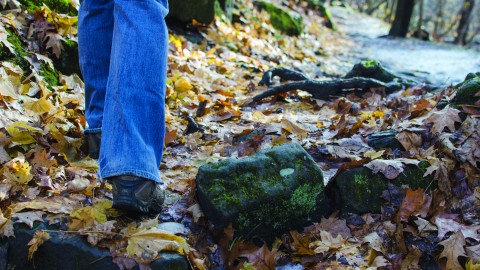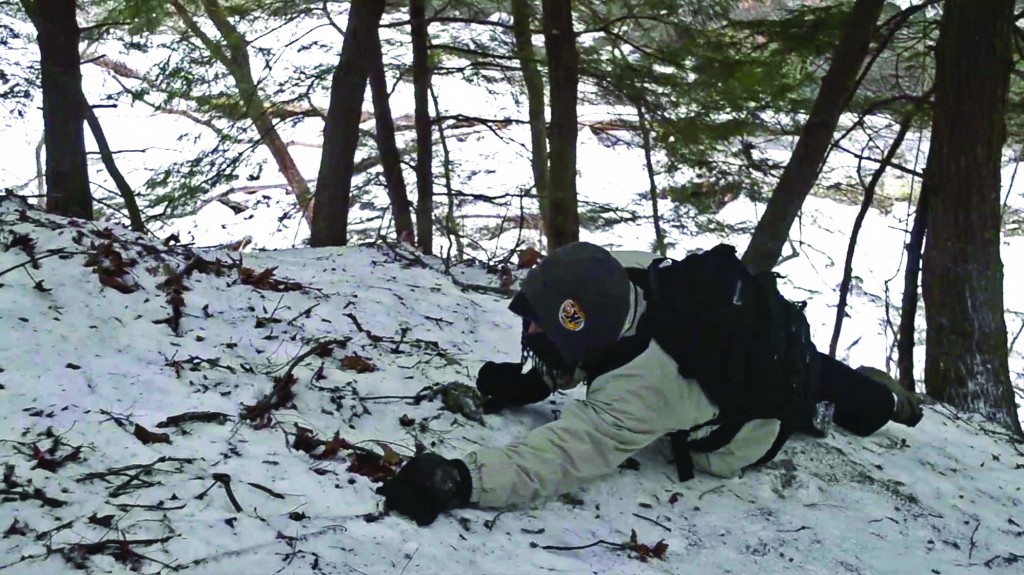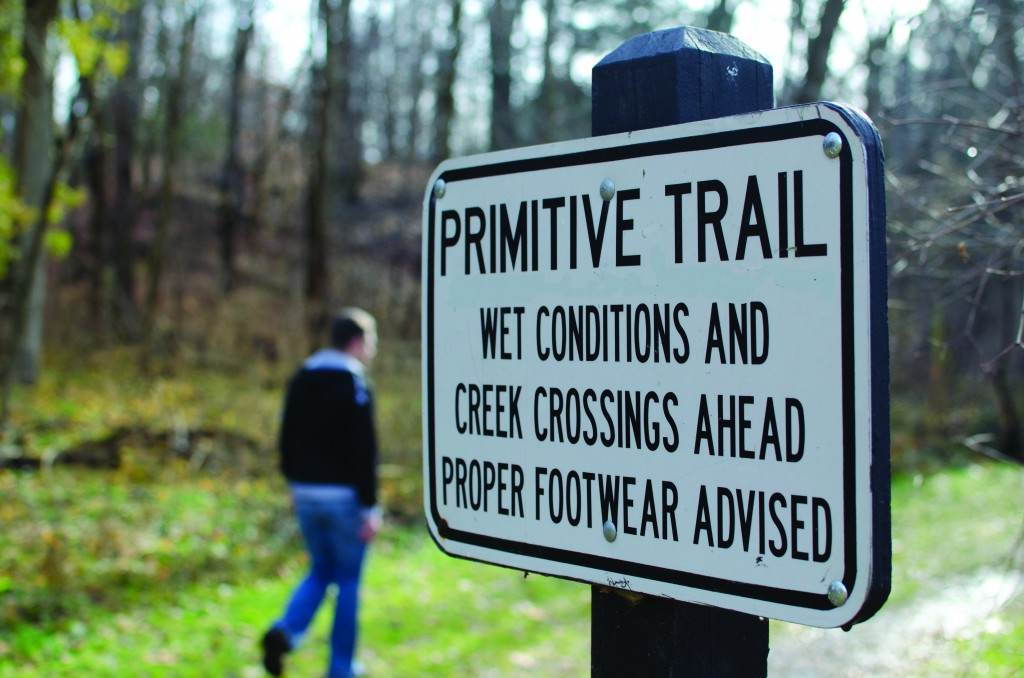By Graig Graziosi

In early 2014, people in Youngstown dug in and prepared for the onslaught of the polar vortex, a pocket of incredibly cold air that sat over and large portion of the northeastern United States for the majority of January.
Jan. 7 was expected to be the coldest in Youngstown. Meteorologists predicted the record low for the day, 6 below zero, would easily be crushed. The news channels exhorted people to stay at home and bundle up. Pet shelters pleaded for owners to bring their pets inside.
My friends and I planned a hike.
There was no reason for the hike beyond the novelty of hiking on the coldest day of the year. We would hike the Hopewell Furnace Trail in Yellow Creek Park, with the intention of seeing the frozen-over waterfall at the end of the trail, then turning back. The three of us going on the trip had hiked the trail in the spring numerous times, and knew every stream crossing and footpath along the trail.
Compared to other hikes I’d taken, Yellow Creek was a breeze. The only kicker that made the trip particularly exciting was the extreme weather, and the only reason that was exciting was because it meant added danger. For me, as for most 27 year olds, danger was a satellite concern; I was aware of its presence, but it never gave me pause, never derailed my decisions.
The morning of the hike, the three of us going — Ray, Sean and myself — layered up as best we could to fight the cold. I wore two pairs of boxers, gym shorts, a pair of jeans and a pair of khakis. On top, I wore two thermal shirts, a hoodie, a large winter jacket and put two skullcaps on to protect my head. I wrapped a scarf around my neck, pulled on a pair of gloves, and the three of us left for the trail.
The temperature that day floated around 12 degrees below zero, and wind chill dropped that further towards 27 below.
We parked at the entrance to Yellow Creek Park, which is actually disconnected from the Hopewell Furnace Trail by way of a through street. The initial hike through Yellow Creek is no different than anything you’d expect to find at Mill Creek Park: well-maintained bridges to provide stream crossings, well-worn footpaths, wide-open areas.
Once we were out of the car and on the path, we were surprised by how not miserable it felt. Sure, it was cold. But it wasn’t supernaturally cold. It didn’t chill me to the core of my bones. My nose didn’t even hurt. Maybe I was just very good at layering.
Upon entering the trail, hikers are welcomed by a sign warning them that they are about to take on a “primitive trail.” There are no established bridges, areas where the trail simply disappears into hill and rocks, and there are no guide marks to help you along the way.
Harsh trails didn’t intimidate me. I had enough tough hikes under my belt: Joshua Tree National Park during the 4th of July, where desert temperatures topped off at 100 degrees and shade was nowhere to be found; Three Sisters Waterfalls outside San Diego, California, where handfuls of hikers are rescued each summer from heat exhaustion brought on due to the sweltering heat and challenging terrain; Ghost Mountain in the Anza Borrego desert, where a wayward step off the trail might reward you with a yucca spine to the leg — a lesson I learned personally. Harder, more dangerous situations had yet to deter me, and a little trail in Struthers, Ohio certainly wasn’t going to stop me, snow or not.
Once we descended into the trail proper, I realized the familiarity I had with the park was fading. The polar vortex turned a park I once knew into something alien, something new, where the rules I was used to following were thrown out the window. The rocks and roots that I could rely on for stable footing in the spring became ice-covered traps, begging me to step on them so they could send me headlong into the white. With each step through the snow, the question loomed as to whether your foot would breach and touch solid ground or swallow your leg into a hole obscured by the powder.
The sounds were different. There were no birdsongs, no quiet bubbling of the creek. Instead, silence gave way to the arbitrarily timed snapping of branches, giving way to the deep freeze inflicting everything in the forest. When we neared the creek, the quiet flow was gone, replaced by the roar of melted ice tearing down the stream. This was a problem.
We thought the river would be frozen over, but we found the opposite. To complete the trail, we had to cross the creek six times total. In the spring, this meant either rock hopping across the shallows or walking along fallen tree trunks that spanned the river. That simply wasn’t an option here. One slip and it was frostbite at best, shock and possibly death at worst. I took stupid risks, not suicidal ones.
We came to a halt where the trail gave way to the icy flow. As we stopped, the sweat we worked up under our clothes began to freeze, and the full force of the polar vortex chill found its way through our bravado. We began to deliberate on how to continue. Turning back wasn’t on the table.
Sean, an Eagle Scout and experienced hiker, suggested rather than attempting to edge along the creek’s banks until we could find an acceptable line of rocks to cross, we take a path higher up, along the various ridges that made up the tiny canyon where we were hiking.
Anyone familiar with Yellow Creek knows of the craggy outcroppings that loom high above the creek side paths, where delinquents display their skills with spray paint and fools decide to climb. Lacking spray paint but burdened with foolishness, we climbed the hills towards the imposing rocks, hoping to find a friendlier path higher up.
The climb was not easy. It was not a shuffle or a hop from tree to tree. The snow betrayed no handholds or secure spots for our feet. We dug in, hands and knees, pulling ourselves up through the snow, higher and higher, until we found a promising spot of flat rock to rest.
Soaked and frozen, we found a crag jutting from the hillside, with a thick tree growing out from dirt hidden beneath the rock, hooking up and around the stone as though it were the masthead on some great petrified ship.
We moved to the crag. It was the worst move of the day. Yellow Creek was tired of us.
Sean and Ray slipped first. What we believed was flat land on the crag was sloped just enough to slip our crew and send them sliding towards the edge. A drop from the crag would likely drop someone five or six feet at most, but the steep, ice-covered hillside would send them tumbling another 35 or 40 feet, potentially to the icy waters racing below.
Neither went over the edge. Sean caught a rock and Ray hooked around a tree, but neither had secure enough footing to pull themselves away from the precipice. I was hesitant to go to them, as a slip from me might send me barreling into one of them, sending both of us tumbling over the edge and down to a terrible end. Ray called out for help, and was in a far worse spot than Sean, who was quickly regaining his footing.
By the time I got to Ray, he had secured himself, and was making his way back onto safer ground. I gave him a hand up, and we rejoined Sean in a more hospitable part of the crag.
Regaining our composure, I took lead, and started for the far edge of the crag where we would find a spot to descend and, hopefully, continue our hike to the waterfall. Finding a smaller outcropping a few feet below the crag’s edge, I reached for a branch to stabilize myself while I descended onto the crag.
The branch in my hand was no longer attached to the tree, and my feet were no longer on solid ground. I fell from the crag, slamming hard into the hill below, and the angry trinity of ice, gravity and momentum began my lesson in hubris.
I slid flat on my back down the hill, like some giant fleshy sled. I felt nothing as I went, simply sliding along, missing trees and large rocks by no skill of my own. By the time my brain kicked in to respond to the situation, I was already nearing the bottom, nearing the creek. I spun from my back to my belly, hoping to slow myself by digging into the hillside or grabbing onto a wayward rock or branch. I bounced off of something, which flipped me back over, and came to what I’m sure was a graceful landing in a snow bank next to the creek.
I immediately popped up, as though somehow if I got up quickly any injury I’d just incurred would be invalidated. On my feet, I felt no immediate pain. No rocks had smashed into my head, no bones felt broken. There was a mild throbbing in my back from the impact of the fall, but nothing that worried me.
I screamed, letting the adrenaline surge through my voice. My friends responded with a mix of curses and questions about my condition.
I assured them I was fine and felt nothing particularly concerning, and after assuaging their concerns took a seat on a nearby log to await their safer, albeit slower, descent from the crag.
As I waited and calmed, my smaller injuries began to make their presence known. A small cut here, a bruise likely to form there. And something wet in my boot. I looked down to see if I had inadvertently rested in some melted ice, and found instead the tan of my boot was now a bright, bright red.
As were the top of my socks and my jeans — in fact, most of the leg under my right knee was sticky with red.
“Hey guys,” I called out, loud and slow. “I think I’m bleeding.”
“You think you’re bleeding? That seems like kind of an either-or thing,” Sean replied from the hillside.
“Yeah. Definitely bleeding,” I replied, slowly rolling up the legs of the jeans and khakis I was wearing to inspect the blood source.
A few inches below my knee, directly in the center of my shin, a three-inch wide hole was torn open, spurting warm blood down my leg. At the time I had no way of knowing how deep the gash cut, and hanging bits of viscera from the wound discouraged me from looking too intently. I had an extra shirt in my backpack, which I balled up and held tightly against the wound.
After a few minutes Sean and Ray arrived on the scene. I showed them the wound, and while neither lost their composure, it was clear neither was comfortable with what they saw. Blood was pooling around me.
“Should we call for an ambulance?” Ray asked, watching the snow turn blood red.
“What are we going to tell them? We’re somewhere in the woods? It’ll take them longer to get to us than if we just try to get out ourselves.” Sean replied, tying the crumpled shirt over the exposed leg wound with a length of paracord.
At 12 degrees below zero, frostbite can set into exposed skin in less than 15 minutes if winds are over 15 mph. The wind speed was over 20 mph, and we were a half hour away from help.
We couldn’t climb out of the gorge, as that would force us right back up the hill that gave me the wound. The hill across the creek was much more manageable, but without a safe crossing, it was impossible to get there. Before too much time passed, we agreed on shuffling along the icy banks.
Once we covered enough ground to find the trail, Sean set off in a sprint through the snow and ice to reach the car so he could have it ready for Ray and I when we emerged from the brush.
Ray guided me along the trail, talking to keep my mind off the wound. It wasn’t difficult to do. There was a strange lack of pain, and I wasn’t entirely sure that it wasn’t related to frostbite. That thought worried me much more than the open hole leaving streaks of red in the snow behind me.
We made surprising time once we hit the trail, and waited only a short time at the trailhead for Sean to swing by with a car. We loaded up, but I stopped Sean from heading towards the hospital. I didn’t have health insurance and wanted to clean up the wound first and get a good look at it before I went in to rack up massive medical bills.
My girlfriend was waiting at the apartment where Sean and I lived, assuming we’d come in cold and dirty, not sweaty and blood drenched. I called her during the car ride to give her a heads up that I would be hobbling through the door and that the whole blood thing wasn’t a big deal.
“A.J.,” I started, doing my best to sound chipper and healthy. “Hey, so, don’t freak out — yeah I know that’s not a great way to start a call — but I got hurt while I was out today. You’re going to see some blood, but don’t freak out, it’s completely fine. OK, I’ll see you soon.”
We returned to the apartment and cleaned the wound. It was deep — and gross. It needed stitches. A.J. was worried about infection. Sean was well aware of what treating this wound would mean to my bank account, and kept an empathetic and consoling smile on as he helped bandage the leg. Ray did his best to keep the mood light and keep A.J. engaged while Sean patched me up.
It wasn’t until later, during the stitching operation at the hospital, that the weight of what just occurred set in fully. The doctor working on my leg explained to me all the ways I could have died that day: cracked my skull on a rock and froze to death in the woods; whatever pierced my leg could have broken my tibia instead of just nicking it, leaving me immobilized in well below freezing temperatures; whatever pierced my leg could have struck higher up in my thigh, severing my femoral artery and leaving me to bleed out in the woods.
The doctor’s list made me think about A.J. and Sean and Ray. I imagined the mental anguish they would have gone through had any of those situations occurred. I thought about my parents, especially my mother who had recently suffered a tragedy of her own, having to bury her son, and my siblings’ pain in burying their brother.
I never thought in terms like those before. I’d been in other potentially life threatening situations before: car crashes in Tijuana; an inattentive drivers forcing me off the highway and into a ditch; getting caught in the middle of a riot in the Republic of the Maldives.
But those didn’t faze me. I was younger during those adventures. I was invincible. People in their 20’s don’t die unless they’re tragic cancer cases or driving drunk. I wasn’t either. I couldn’t be touched.
Then I got a hole in my leg. But sometime before that, I started dating someone I really love. And I recognized the value of friends who have struggled and conquered alongside me for years and years. I finally began to appreciate my parents as not just my parents, but as adults trying to make adult decisions while raising a family.
They showed me the crack in my armor. They forced me to look at the hole in my defenses. I realized I could no longer justify taking needlessly stupid risks, not because intentionally exposing myself to danger was scary, but because it was selfish. If I had died on the hill, I would be swimming in the black right now, leaving my loved ones with the bill of sadness and trauma associated with losing someone you care about.
The invincible man I believed myself to be died on the hill. I can feel his absence when I take pause before leaping to do something needlessly risky. I know he’s gone when I consider how my actions may affect my loved ones, rather than what risk my actions pose to me alone.
Today I more fully consider my actions. I pause more, but I’d like to believe there are still many adventures left for me. I still have risks left to take; risks I consider reasonable. Eventually I’m sure I’ll grow out of those risks as well, but you’ll have to wait for “Death of the Stupid Man” for that story.


